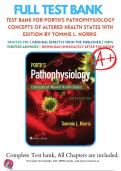Exam (elaborations)
Test Bank for Porth's Pathophysiology Concepts of Altered Health States 10th Edition by Tommie L. Norris | 2018/2019 | 9781496377555 | Chapter 1-52 | Complete Questions and Answers A+
- Course
- Institution
- Book
Boost your pathophysiology exam performance with the 'Test Bank for Porth's Pathophysiology: Concepts of Altered Health States' 10th Edition by Tommie L. Norris. Get instant access to an original publisher-sourced PDF containing comprehensive Questions and Answers covering chapters 1-52. Simplify y...
[Show more]



